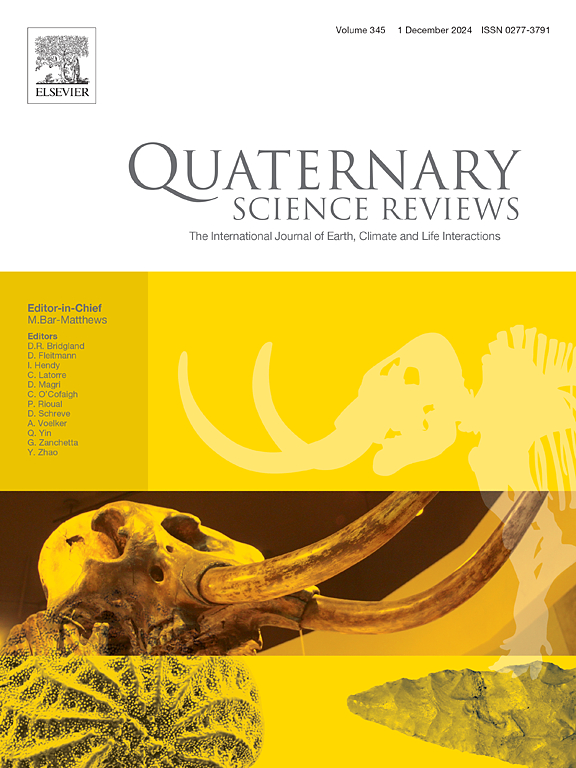智利北部Pampa del Tamarugal盆地Chipana silcrete的成因、特征及岩屑管理
IF 3.2
1区 地球科学
Q1 GEOGRAPHY, PHYSICAL
引用次数: 0
摘要
硅化岩,或硅石,是人类在13000年前穿越阿塔卡马沙漠时高度利用的资源。这些过去的群体在哪里以及如何获得原材料的问题对于了解他们所遵循的路线以及他们用于获取和转化岩石的机制至关重要。“奇帕纳”是观察这一点并描述其来源和开采岩石类型的一个典型案例,因为它既是一个来源,也是一个考古遗址。它是塔马鲁加尔Pampa del Tamarugal已知的最大和最古老的石器供应点。运用岩石考古学的跨学科视角,对其来源进行了表征,并通过技术经济方法对遗址的石器技术进行了分析。主要结果表明,奇帕纳可能对应于一个大型的原始岩石来源,被确定为白色硅砾岩,特别是含有蛋白石二氧化硅的重硅化石灰岩。这是通过扫描电子显微镜分析确定的,它揭示了石灰石的典型化学元素,并通过岩石学分析观察到岩石的结构(即纤维二氧化硅)。烃源岩存在4种相变化,其形成与成岩作用有关。它有一个适合石器敲击的贝壳状骨折,这就是为什么它被过去的人类群体所寻找的原因。考古遗址对应于一个专注于双面技术的石器作坊,用于生产大型双面(长度为13厘米)。对于各种工具的单面技术,也观察到二次生产。因此,Chipana为开始绘制潘帕草原的石器景观提供了新的数据,并改进了我们对人类如何通过利用岩石等可用的当地资源来适应和利用有限生物量的超干旱环境的理解。此外,它有助于我们了解居住在阿塔卡马的最古老的狩猎采集者,作为南美洲人类定居点的一部分。本文章由计算机程序翻译,如有差异,请以英文原文为准。
Origin, characterisation and lithic management of the Chipana silcrete in the Pampa del Tamarugal basin, northern Chile
Silicified rocks, or silicites, were a highly utilized resource by human groups that traversed the Atacama Desert around 13,000 cal yr BP. The questions of where and how these past groups obtained the raw materials are crucial for understanding the routes they followed and the mechanisms they used for acquiring and transforming the rock. An exemplary case to observe this and to characterize the type of source and rock exploited is “Chipana,” as it is both a source and an archaeological site. It is the largest and oldest known lithic provisioning point in the Pampa del Tamarugal. Using the interdisciplinary perspective of petroarchaeology, the source was characterized, and the lithic technology of the site was analyzed through a techno-economic approach. The main results show that Chipana likely corresponds to a large primary source of rock identified as white silcrete, specifically a heavily silicified limestone with opaline silica. This was identified through scanning electron microscopy analyses, which revealed chemical elements typical of limestone, and through the rock's structure (i.e., fibrous silica) observed via petrographic analysis. Four facies variations of the rock were observed at the source, and its formation is associated with diagenetic activity. It has a conchoidal fracture suitable for lithic knapping, which is why it was sought after by past human groups. The archaeological site corresponds to a lithic workshop focused on bifacial technology for producing large bifaces (13 cm in length). A secondary production is also observed of unifacial technology for knapping a variety of tools. Thus, Chipana provides new data for beginning to map out the lithic landscape of the Pampa and refines our understanding of how humans adapted to and utilized a hyper-arid environment with limited biomass by making use of available local resources such as rock. Additionally, it contributes to our knowledge of the oldest hunter-gatherers who populated the Atacama, as part of the human settlement of South America.
求助全文
通过发布文献求助,成功后即可免费获取论文全文。
去求助
来源期刊

Quaternary Science Reviews
地学-地球科学综合
CiteScore
7.50
自引率
15.00%
发文量
388
审稿时长
3 months
期刊介绍:
Quaternary Science Reviews caters for all aspects of Quaternary science, and includes, for example, geology, geomorphology, geography, archaeology, soil science, palaeobotany, palaeontology, palaeoclimatology and the full range of applicable dating methods. The dividing line between what constitutes the review paper and one which contains new original data is not easy to establish, so QSR also publishes papers with new data especially if these perform a review function. All the Quaternary sciences are changing rapidly and subject to re-evaluation as the pace of discovery quickens; thus the diverse but comprehensive role of Quaternary Science Reviews keeps readers abreast of the wider issues relating to new developments in the field.
 求助内容:
求助内容: 应助结果提醒方式:
应助结果提醒方式:


